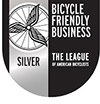At Highmark, our efforts to become a more sustainable company align with our corporate values, specifically stewardship. We strive to improve the health of the communities we serve and manage the assets that have been entrusted to our care, which drives the realization of our corporate mission.
By helping to protect the environment, we can better nurture good personal health — for our members, other customers, employees and the communities in our region.
Our sustainability initiatives not only have significant environmental benefits but have helped our company become even more efficient and cost-effective.
Our community partners and vendors are invaluable in helping us to capitalize on new opportunities to save energy, trees, other resources and dollars, too.
Our four overall sustainability goals include:
Read more information on what you can do to adopt more environmental-friendly practices.
Learn more about Highmark Health's sustainability program.



